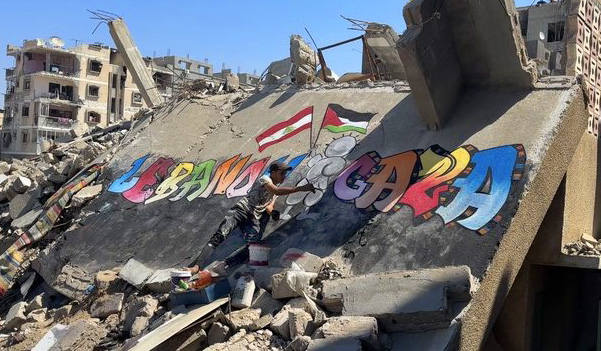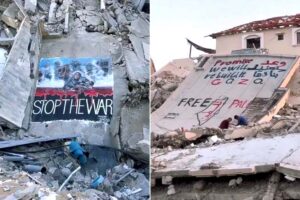‘WE promise we will rebuild them.’ These words were written by a Palestinian on the walls of a house demolished by Israeli airstrikes in northern Gaza, sending a message of resilience and defiance against the occupation, which has been trying to empty the region of its inhabitants for the past 28 days.
The drawings and writings on the walls have become a means of expressing perseverance, resistance, and defiance against the occupation in northern Gaza, which is facing one of the fiercest campaigns of Israeli ethnic cleansing since October 5.
On the wall of one home, a Palestinian artist painted a picture of a Palestinian woman holding her child around a pool of blood, with destroyed houses in the background, along with the words in English: ‘Stop the war.’
‘We remain and will not leave,’ said Amer Khalil. ‘The occupation is trying to kill us and displace us, and we are telling it through all means, including these words and drawings, that we are staying and will not leave. We are the rightful owners of the land, and we will rebuild our homes.’
On the walls of another house, someone wrote: ‘My home, even if you destroy it, I will not leave,’ to express the Palestinians’ determination to stay, despite the genocide and brutal massacres being carried out by the Israeli occupation forces for the past 28 days, aiming to displace the residents and turn northern Gaza into a buffer zone.
On one of the mosques, someone wrote: ‘Gaza will remain ours, even if the whole world fails us.’
Eviction orders
During the past month, the occupation forces issued five eviction orders, the latest last Friday morning, targeting citizens in northern Gaza.
They committed dozens of massacres in homes and shelters, killing more than 1,200 Palestinians and injuring over 2,000 others.
Activists and local media circulated a video showing how the walls of destroyed homes in northern Gaza have turned into murals of resilience; murals standing against the siege and the Israeli military operation.
The phrases and drawings on the walls varied between rejecting forced displacement and calls to stop the war on Gaza.
Among the most prominent phrases were: ‘Stop the war,’ ‘Freedom for Palestine,’ ‘Tomorrow we will rebuild it,’ ‘Even the birds in Gaza have wings and do not migrate,’ ‘My son is still under the rubble,’ ‘Sufficient for us is Allah, and He is the best disposer of affairs,’ ‘I will not leave,’ and ‘We remain like thyme and olives.’
Since October 5, the Israeli army has begun unprecedented bombing operations on the Jabalia camp, town, and large areas in northern Gaza, before invading it the next day, warning of its intention to implement the Generals’ Plan to empty the region.
Since October 7, 2023, Israel, with absolute American support, has been waging war on Gaza, resulting in over 144,000 Palestinian martyrs and injured, most of whom are children and women, and more than 10,000 missing, amid massive destruction and famine that has killed dozens of children and the elderly, in one of the worst humanitarian disasters in the world.
The Israeli forces continue their aggression and terror, from the Gaza Strip to Lebanon, issuing orders for forced evacuations that include the Rashidiya refugee camp near Tyre.
This decision has been met with widespread rejection from the camp’s residents.
The Israeli army issued last Thursday evacuation orders for villages and towns in southern Lebanon, notably the Rashidiya refugee camp, which is the first camp to receive such orders for forced relocation, in addition to other villages in the region.
The Arabic language spokesman of the Israeli army, Avichay Adraee, claimed via X platform that these areas are witnessing activities by Hezbollah; a statement denied by the camp’s residents, who confirmed that the camp is an isolated area inhabited solely by Palestinian civilians.
Resilient despite evacuation orders
The forced evacuation decision has created a state of tension and panic among the camp’s residents.
However, a significant number of them have decided to remain in the camp after enduring the hardships of repeated displacement and the associated harsh conditions.
According to locals, 3,000 Palestinians in the Rashidiya camp refuse to leave their homes, showcasing a scene of defiance and resilience.
The camp is located about 13 kilometres from the Palestinian-Lebanese border, five kilometres south of Tyre, covering an area of 228 dunums, making it the largest of the three camps in the Tyre area and one of the largest Palestinian refugee camps in Lebanon, which has a total of 12 camps.
About Rashidiya camp
The Rashidiya camp consists of two camps, old and new; the first was established by the French government to accommodate Armenian refugees who arrived in Lebanon in 1936.
In 1949, UNRWA leased the land from the Lebanese government, and it was inhabited by Palestinian refugees after the Armenians were displaced.
The second camp was established by UNRWA in 1963 to receive refugees, most of whom had been living in the Ghoro camp in Baalbek.
According to UNRWA records, the number of registered Palestinian refugees in Rashidiya camp is 36,595, while the number of residents is 27,000.
However, popular committees estimate the number to be around 22,000.
Imad al-Halaq, the director of the Palestinian Red Crescent in the Tyre area, said that since the announcement of the threat to evacuate Rashidiya camp, it was natural to witness movement of displacement, particularly among families with elderly members or medical cases.
He noted that about three weeks ago, there was a wave of displacement from the camp following a previous evacuation threat that affected the area, but many of those displaced returned to the camp afterward, restoring its normal vitality.
He added: ‘After the latest threat, a new wave of displacement began, and we cannot yet count the number of those who left the camp.
‘Many families are still in the camp and refuse to leave their homes.
‘The camp’s residents have experienced displacement before and know the extent of the suffering.’
Civil defence mobilisation
Al-Halaq further continues that the Palestinian civil defence is on high alert and has coordinated with hospitals in the vicinity of the camp, in case assistance is needed for transporting the injured or if there is a need to transfer patients.
‘Our teams are present and ready to intervene if the camp is targeted, and we have an emergency centre in the nearby Al-Bass camp.
‘We are also in constant communication with Lebanese hospitals, coordinating as needed.
‘There are no shelters in the camp, and those who have not left are staying in their homes, considering them places of refuge.
‘If the camp is subjected to heavy targeting, we do not know what will happen, but we hope there will be no targeting, and that all residents will return to their homes,’ he added.
Death before displacement
Palestinian Muhammad Abu Qarar, a resident of the Rashidiya camp, said that he decided not to leave the camp, explaining that he cannot bear the horrors of displacement, preferring death in the camp’s alleyways over being displaced.
Abu Qarar expressed great fear and panic, despite having experienced many events in Palestinian camps, including siege and hunger.
However, he indicated that at his current age, he cannot endure the hardships of displacement, saying: ‘If I am destined to die, then welcome martyrdom.’
Another refugee, Muhammad Abu Qamar, stated that for the first time, the occupation army is directly threatening Palestinian camps in such a manner, marking a dangerous precedent since the camps have large populations and dilapidated homes.
He added that the camps in Sidon have seen significant displacement from the camps and gatherings in Tyre.
He, along with his wife and children, decided not to leave the camp, saying: ‘We have no place to go, and we won’t leave except as martyrs. Death in our homes is better than humiliation at the doors of shelters.’
He continued that he experienced displacement a few weeks ago, and when he reached the shelters, he faced severe hardships regarding sleep, food, and water. For this reason, he decided to stay at home, saying: ‘We will not leave the camp except for Palestine.’

